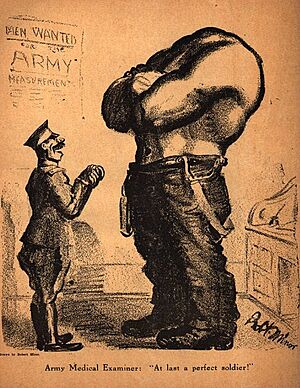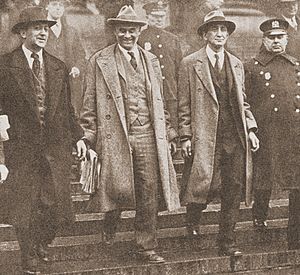Robert Minor facts for kids
Robert Berkeley "Bob" Minor (born July 15, 1884 – died January 26, 1952) was a famous cartoonist and journalist. He was also a key member of the American Communist Party starting in 1920. People sometimes called him "Fighting Bob."
Contents
Early Life
Robert "Bob" Minor was born in San Antonio, Texas, on July 15, 1884. His family had some well-known ancestors. For example, General John Minor worked for Thomas Jefferson during his election campaign. His mother was related to General Sam Houston, who was the first President of the Republic of Texas. Bob's father was a teacher and a lawyer who later became a judge. His grandfather on his mother's side was a doctor.
Even with these famous family members, Bob Minor did not grow up rich. His family faced tough times financially. They lived in a simple house in San Antonio. Bob could not start school until he was 10 years old because his family needed money. He left school at 14 to work as a messenger boy for Western Union to help his family. Two years later, he left home and worked many different jobs. He was a sign painter, a carpenter, a farm worker, and a railroad worker.
Career Path
In 1904, when he was 20, Robert Minor got a job at the San Antonio Gazette. He started as an assistant and used his free time to practice drawing. Soon, he became a very skilled political cartoonist.
Becoming a Cartoonist
Minor moved to St. Louis to work as a cartoonist for the St. Louis Post-Dispatch. At first, he drew with pen and ink. But then he started using grease crayon on paper, which changed his style. Minor became the main cartoonist at the Post-Dispatch. Many people thought he was one of the best cartoonists in the country.
In 1911, the New York World hired Robert Minor. He became the highest-paid cartoonist in the United States. Around the same time, his father also became more successful. He went from being a lawyer who wasn't doing well to an important judge.
Working as a Journalist

In 1907, Minor joined the Socialist Party of America. By 1912, he started to support anarchism, which is a belief in no government. He also supported syndicalism, which means workers should control industries.
Minor had saved money and wanted to go to Paris to study art. He joined a class at the Ecole des Beaux Arts, a famous French art school. But he didn't like it much. He spent his time in Paris studying art on his own. He also joined the labor movement through the Socialist Party of France. Minor came back to the United States in 1914, right before World War I started.
In 1914, Minor was still getting paid by the New York World even though he wasn't working. This was to stop him from drawing for other newspapers. When the war began in August, Minor started drawing strong cartoons. These cartoons criticized both sides of the war for their desire to control other countries. The World used some of his cartoons at first. But soon, they asked him to draw cartoons that supported the war. Minor was strongly against the war. He had to choose between his job and his beliefs. He chose his beliefs and ended his contract with The World.
On June 1, 1915, Minor started working for the New York Call. This was a daily newspaper connected to the Socialist Party of America. Minor also drew powerful anti-war cartoons for The Masses, a radical magazine in New York. His cartoons later caused problems for The Masses. The U.S. government tried to stop the magazine because of the Espionage Act of 1917. This eventually led to the magazine closing. Minor later joined the staff of The Liberator, a new magazine started by Max Eastman.
The Call sent Minor to Europe as a war correspondent. He wrote from France and Italy. A newspaper group helped pay for his trip. But they couldn't use his radical drawings from the war front. So, The Call had to call him back from Europe.
In 1916, The Call sent Minor to Mexico to report on the American military action there. When the "Mexican War" ended, Minor went to California to rest. There, he got involved in helping Tom Mooney and Warren Billings. These two trade unionists were accused of bombing a parade in San Francisco in 1916. Minor worked for a year and a half as the publicity director for the International Workers Defense League. This group helped Mooney and Billings with legal support and public sympathy. Minor wrote several booklets in 1917 and 1918. He spoke to many groups about how he believed Mooney and Billings were wrongly accused.
In 1918, The Call sent Minor back to Europe as a war correspondent. He continued to write about the revolutionary movement in Europe for The Liberator. In May 1918, Minor arrived in Soviet Russia. He stayed there until November. While there, he met Vladimir Lenin and wrote anti-war messages for English-speaking soldiers. This experience changed Minor greatly. It made him believe in communism. Minor then traveled to Germany, where he saw the German Revolution happening. After that, he went to France.
In Paris in 1919, Minor was arrested. He was accused of treason for telling French railway workers to strike. He wanted them to stop sending weapons to forces fighting against Soviet Russia. Minor was sent to an American military prison in Coblenz, Germany for several weeks. He was eventually released thanks to political pressure from his well-connected family in America.
Becoming a Communist Leader
When he returned to America in 1920, Minor immediately joined the American Communist Party. He supported the United Communist Party during a time of many disagreements within the party. He joined the newly united Communist Party of America (CPA) when his group merged with the old CPA in the spring of 1921.
After the merger in May 1921, Minor, using his secret name "Ballister," was sent to Soviet Russia. He represented the new party to the Executive Committee of the Communist International (ECCI). Minor also attended the 3rd World Congress of the Comintern in Moscow in June 1921. There, he met Lenin for a second time. The CPA called Minor back to America in November 1921.
Minor became part of the CPA's main governing group, the Central Executive Committee, on April 24, 1922. He was re-elected at a convention in August 1922 near Bridgman. This meeting was raided by police and federal agents. Minor was wanted by the police and turned himself in with nine others on March 10, 1923. He was released soon after on bond. He was never tried for breaking a Michigan law about workers' groups.
From 1923 to 1924, Minor was on the Executive Committee of the Friends of Soviet Russia. This group helped the Soviet Union. He was also elected to the governing committee of the Workers Party of America, which was a legal political group connected to the CPA. In 1926, he was elected to the ECCI again and to its inner group, the Presidium, using the name "Duncan."
Minor was in charge of the Party's Central Committee for Negro Work. He helped the Communists try to work with Marcus Garvey and his group, the Universal Negro Improvement Association and African Communities League. In the mid-1920s, Minor was loyal to the group led by C.E. Ruthenberg. Minor was upset when a proposal for "Negro Equality" was changed at a meeting in 1924. He felt the party leaders made changes to please anti-Black farmers and union leaders.
On March 6, 1930, Minor took part in large protests for unemployed people across the United States. These protests were organized by the Communist Party. Minor was arrested at a protest in Union Square in New York City. This protest ended in a clash between marchers and police. Minor was arrested with other Communist Party members, William Z. Foster, Israel Amter, and Harry Felton. They were sentenced to three years in a New York state prison. After six months, Minor became sick with appendicitis. He was taken to a hospital for surgery. Minor spent most of the next two years trying to get better.
Bob Minor ran for political office several times. In 1924, he ran for U.S. Congress in Illinois. In 1928, he ran for U.S. Senator from New York. He ran for Congress from New York again in 1930 and 1940. He also ran for Mayor of New York City in 1933. In 1936, he was the Communist Party's candidate for Governor of New York.
At a big meeting of the Comintern in 1935, Minor was elected to the International Control Commission. This group handled jobs and rules for members. He strongly supported all the changes in Soviet foreign policy throughout the 1930s.
When the Spanish Civil War started in 1936, Robert Minor went to Spain. He helped create the Abraham Lincoln Battalion. This group of international volunteers helped the Spanish government fight against General Francisco Franco and his fascist supporters, who were backed by Nazis.
In 1941, the leader of the Communist Party, Earl Browder, was in jail. Minor served as the acting General Secretary of the party during that time.
In 1945, Minor was a member of the Communist Party's National Committee. He distanced himself from Browder, who was no longer popular. Minor was then given the job of Washington correspondent for The Daily Worker.
Bob Minor had a heart attack in 1948. He was bedridden during the time of McCarthyism, when many other Communist Party leaders were arrested. Because of his poor health, the U.S. government decided not to take legal action against him.
Death
Robert Minor passed away in 1952. His wife, the artist Lydia Gibson, survived him. They did not have any children.
Legacy
Some people remember Minor as the inspiration for a character named "Don Stevens" in John Dos Passos' book series USA.
The historian Theodore Draper said about Minor: Minor was a person of extremes. He was a truly talented cartoonist, but he gave up art for politics. He did this even after being an anarchist who disliked politics for years. But he couldn't use his artistic talent in politics. His exciting drawings were replaced by boring speeches. He wasn't a natural politician and only used simple phrases. The wild man became a simple political worker. If he thought politics was dirty as an anarchist, he still seemed to think so as a Communist – only now it was his job.
Minor's old papers are kept at Butler Library at Columbia University. There are about 15,000 items in his collection.
Selected Works
Books, pamphlets, articles
- 1916: "War Pictures," New York Call
- 1917: The Frame-Up System: Story of So-Called Bomb Trials in San Francisco. San Francisco: International Worker's Defense League
- 1920: Stedman's Red Raid. Cleveland: Toiler Publishing Association
- 1921: "Resolved: That the Terms of the Third International are Inacceptable to the Revolutionary Socialists of the World": Being the Report of a Debate, Held in Star Casino, New York City, Sunday, January Sixteenth, 1921: Affirmative James Oneal vs. Negative Robert Minor. New York: Academy Press
- 1936: The Struggle Against War: And the Peace Policy of the Soviet Union. New York: Workers Library Publishers
- 1941: The Fight Against Hitlerism. New York: Workers Library Publishers, 1941. (With William Z. Foster.)
- 1942:
- Free Earl Browder!
- The Year of Great Decision, 1942. New York: Workers Library Publishers, 1942
- 1943: Invitation to Join the Communist Party. New York: Workers Library Publishers
- 1944: The Heritage of the Communist Political Association. New York: Workers Library Publishers
- 1946: Lynching and Frame-up in Tennessee. New York: Workers Library Publishers



